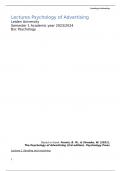Psychology of Advertising
Lectures Psychology of Advertising
Leiden University
Semester 1 Academic year 2023/2024
Bsc Psychology
Based on book: Fennis, B. M., & Stroebe, W. (2021).
The Psychology of Advertising (3rd edition). Psychology Press
Lecture 1 Sending and receiving
1
, Psychology of Advertising
Goals of this lecture:
What is the function of advertising?
What hierarchical models of advertising entail
What are the phases of processing?
How can each processing phase can be influenced by advertising?
This lecture is about sending (advertising) and receiving (the consumers).
Advertising: any form of paid communication by an identified sponsor aimed to inform
or persuade target audiences about an organization, product, service or idea (don’t
remember this detailed, because we know what is meant by advertising). Advertising is
all around us and we see approximately around 1000 ads per day.
Functions of advertising:
1. Existence of television programs, newspapers, magazines & public events. This
is because they are sponsored by the advertisement.
2. Employment: not just the events or programs that people advertise for but also
for the people that really work in advertising.
3. Information function: to inform people about certain products or coming
events, where to find them or its price.
4. Persuasion function: forming, strengthening, or changing attitudes through
advertising. This can influence consumer behavior. This is where we are going to
focus on in this course and can be done in three ways (ABC):
a. Affective (feelings): is about influencing your emotions during an
advertisement. So, it is about product liking & emotional response to
an ad (e.g. surprise, fear, or interest).
b. Behavioral (actions): is about influencing the consumer’s behavior. You
don’t just want to intend them to buy it, but you really want them to take
action and make them buy the product, so it is about purchase
intention.
c. Cognitive (thoughts): If you advertise your product you want people to
recognize your product in the shop and remember what the advertisement
was about. So it is about recognition and memory, but also about
beliefs and thoughts about the ad, brand or product.
Hierarchy of Effects models: DAGMAR & FCB GRID
As discussed above a person can be affected in 3 ways (ABC). The order in which you
are affected can be described by hierarchy of effects models. DAGMAR is one of
them and states the influencing process is done in a very specific order:
D = DEFINING Unaware
A = ADVERTISING Aware
G = GOAL Comprehension & Image
M = MEASURED Attitude
A = ADVERTISING Action
R = RESULT
However, criticist say not everyone goes through every step and maybe skip some
steps. It can also be the case people do go through every step, but they don’t do it
consciously. However, you can use this model to look which steps CAN be involved.
Another Hierarchy of effects model is the FCB Grid, which is about the order in which
you experience the feel (how do you feel by buying this product), think (should I buy
this product) and do (the actually buying) of a product. The model states this is about
your involvement in a product is high or low (because of e.g. the price of it) and
whether it is a think or feel product (the difference between a practical product or
something that means much to you).
2
, Psychology of Advertising
High involvement + think = Think – feel – do informative, e.g. washing machine.
High involvement + feel = Feel – think – do Affective, e.g. perfume or jewelry.
Low involvement + think = Do – think – feel Habit, e.g. toilet paper.
Low involvement + feel = Do – feel – think Self-satisfaction, e.g. chocolate or ice
cream.
Processing advertising messages
The processing of advertising (receiving) messages consists of four stages. It starts
with an unconscious/automatic stage and goes to a conscious and reflective stage.
Stage 1: Preattentive analysis
This is the unconscious part of advertising. Often, consumers learn about products
incidentally (e.g., in newspaper, magazine, on television, internet). Not much attention
is being paid and the consumer is just scanning the information. However, all of the
information still makes an impact through unconscious and implicit processes.
Information gets in the implicit memory which can be retrieved later. Preattentive
processing can rely on a few things:
Perceptual analysis/processing: physical features, like colors or contours. It was
long thought people were only able to process these features in this stage.
Conceptual analysis/processing: product use and usage situation. Since some time,
they found this could also be processed in this stage. This is because they found it can
have effects on a consumer even if a product looks perceptually different than an ad. It
even can have stronger effects than perceptual processing. Shapiro (1999) showed this
in a study in which he showed an ad of a telephone in the preattentive stage. One
group got to see the phone isolated and the other group got to see the phone in usage.
After that both groups got to see a catalogue with all sorts of isolated products. If the
memory in this stage was just based on perceptual processing, the memory should be
better in the group which got to see the product the same 2 times exactly the same (in
an isolated way). However the memory was actually better for the product that was
showed in context. So this context facilitated memory, regardless of whether there was
a perceptual match between the ad stimulus and the product in the catalogue. This
shows us the processing is mainly based on the concept, not necessarily on physical
features.
Another concept that is related to this stage is hedonic fluency: this is the subjective
ease with which a stimulus can be perceived and processed. So, this is basically that if
something can be perceived and processed easily, it evokes positive emotions and this
is attributed to the stimulus. For example, a easy to read font has a higher perceptual
fluency than a hard to read font, which in turn has a lower perceptual fluency. You also
have conceptual fluency, which is about concepts that have a logical match or not.
So if the concepts of an advertisement match easily (like a sportsman and sportsdrink),
it has a higher conceptual fluency, then when the concepts of an advertisement do not
match easily (like a sportsman and tea).
Another thing that helps this easy of processing is familiarity. Familiar stimuli are
processed more easily because they are known already and therefore are easily. Think
for example of familiar songs. The concept that you like things more that you see more
often is known as the mere exposure effect. If you have a neutral product and you
see it over and over again, you gain more positive feelings or evaluations to this
product.
Stage 2: Focal attention
3






